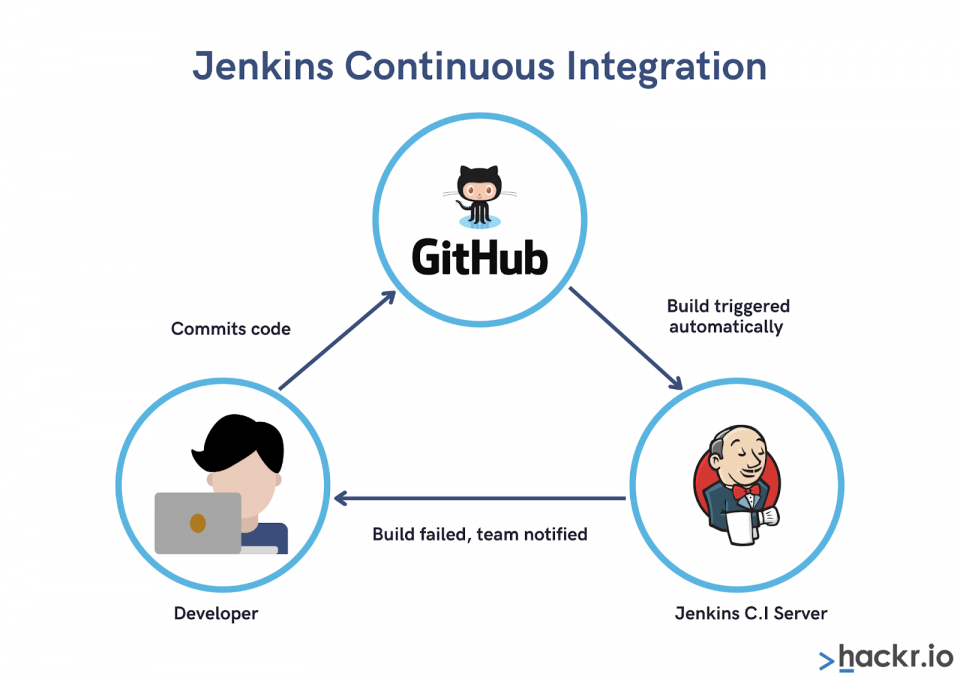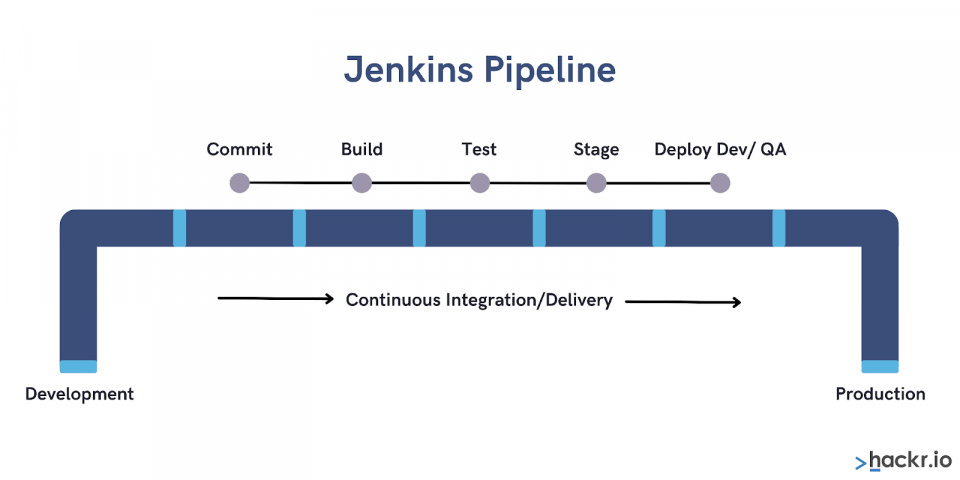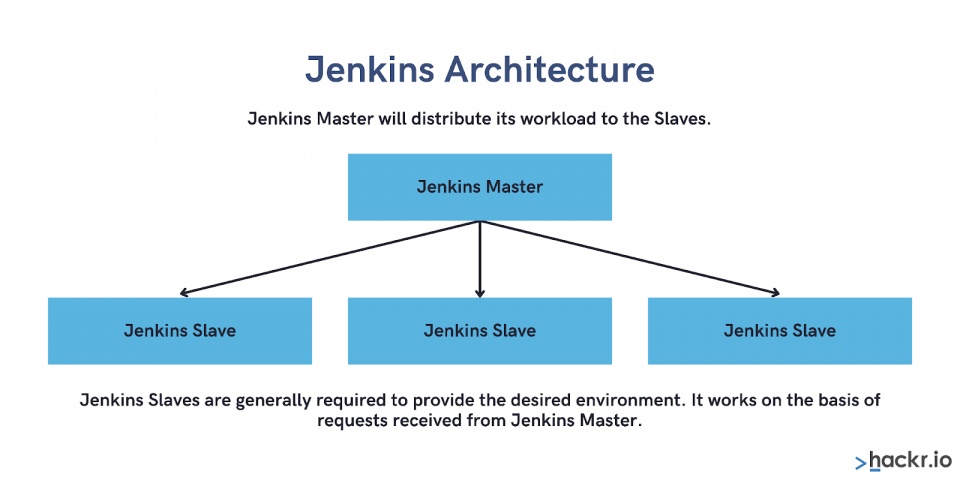When we talk about continuous integration or round-the-clock delivery (CI/CD) tools, there's one joyride that A-one that heel: Jenkins. Information technology is the most famous ASCII text file 101/Compact disk tool used to support DevOps with several other cloud-native tools.
Jenkins is an open-germ mechanisation server. With this incredible server, it is workable to escalate the software program evolution process away automation. End-to-end the life cycle, it helps you cope package delivery processes. Varied life cycle stages dwell of building, testing, documenting, publicity, theatrical production, deployment, and much more.
This clause will aid you in agreement the Jenkins ecosystem in detail.
What is Jenkins?
Kohsuke Kawaguchi created Jenkins in 2004. The sole objective of Jenkins is to execute continuous integration. Jenkins is the most popularly chosen solution for continual delivery across the globe.
Jenkins is a continuous integration tool written in Java that allows continuous development, test, and deployment of newly created codes.
Jenkins was written originally by the community as a build and freeing tool. It is a server-based application and requires a web server like Apache Tom. Jenkins allows users to build and test projects continuously making it easier for developers to integrate changes to the contrive, and making it easier for users to obtain a fresh physical body .
Now, let United States of America analyze the construct of continuous integration!
What is Continuous Integration?
Continuous desegregation is a function to integrate all the code changes done by several developers in one project. A code is repeatedly tested after a commit to guarantee the code is error and bug-free.

As there are several team members in the evolution team, there are chances of bugs in multiple commits. With 101, it is easier to detect these bugs early before pushing the changes in production. The integration of every art object of code into extraordinary executable form takes place, known as a build. If this chassis is immature, then the executed code is ready for deployment. Other, the team has to ensconce the bug and repeat the entire process from scratch.
This is a around-the-clock swear out; therefore, the name, continuous integration operating theater round-the-clock deployment.
Moreover, the backbone of this tool is the Jenkins community. This incredible community supports the externalize and plays a world-shaking role in its succeeder. Jenkins has grown exponentially since its development. At present, there are millions of downloads and agile users of Jenkins.
But the real question is, how does Jenkins accomplish continuous integration? It uses plug-ins to integrate several DevOps stages. If you wish to integrate, all you need is to put in the plug-Immigration and Naturalization Service, and you are good to die!
What is Jenkins Used For?
As a continuous integration tool, Jenkins helps development teams nam errors in the early stages of a project, A fit As automate the integration process of parvenu code. Ci/CD is a significant part of the DevOps process and plays an important role in everything from startups to the largest technical school companies like Netflix.
The actual involvement of Jenkins in the development process is as follows:
- Developers start out committing code to the repository, which Jenkins checks regularly
- If there is a change in the code, Jenkins compiles the code
- If thither is a failed build, the developer gets notified
- If the build is successful, the encode is deployed to production
The large number of plugins are also quite useful, American Samoa they offer a lot of customizability. As a whole, it's quite a flexible and can work in different environments. Jenkins also allows you to schedule tests based on particular events, and you can set the frequency of these tests. You don't have to run the trial run manually.
Features of Jenkins
Jenkins has some features that really sell it as a CI/CD tool. These are some of them:
- Plug-ins
- Easy to set up
- Supports virtually environments
- Open-source
- Easy distribution
Plug-ins
The availability of thousands of plug-ins allows for a large degree of customizability. The developers experience the opportunity to integrate these plug-Immigration and Naturalization Service with development and testing tools, and tailor the computer architecture to serve a lot of possibilities.
Easy to Set Up
At that place are executable packages that quickly install Jenkins on Windows, Mac and Unix operative systems, atomic number 3 IT is just a self-contained Java program. You give notice set out it set up in under 10 minutes.
Supports Most Environments
Jenkins supports most environments, including obnubilate-settled architecture. This makes it handy as teams begin to use various environments. All major cloud platforms are based on, including Amazon, Azure, Google, and IBM Cloud.
ASCII text file
Jenkins is open-source and free to use. Jenkins has an eager developer biotic community that frequently holds meetings, some in-person and online.
Easy distribution
It's easy to distribute Jenkins crossways work machines, which makes building, testing, and deployment faster.
After understanding the fundamental principle, let us analyze the works of Jenkins in point.
How Does Jenkins Work?
At first, a developer commits the encrypt to the source code. Instantly, the Jenkins server keeps a regular check at the repository. As soon arsenic the commit occurs, the Jenkins server discovers the changes and pulls them. Further, it prepares a new build up.
If in between the tests, the chassis does not pass, the developer is instantly notified to withdraw suitable action. Straight off, Jenkins gets ready for the deployment of the build to an environment that allows whatsoever User Toleration Testing (UAT) in front the release into the product word of mouth.
The above-performed UAT tests are automated with the aid of a puppet called Selenium to achieve continuous legal transfer. The cypher is appended to the master branch to create a gilt build if the test is passed. IT is then directly deployed into the product pipeline.
After testing, Jenkins notifies the developers regarding the test results and build.
Now, the whole cycle goes on repeatedly.
In Jenkins, you prat easily work out out which give was the reason behind the failure of the build. However, if each the social unit tests pass, the build word of mouth will move forward to the next arrange.
Jenkins runs parallel builds across individual machines to lessen the total time consumed to complete the strange activities.
What is more, several multinational companies such as Google and Amazon have achieved the continuous delivery milestone. It helps them to deploy to production respective times a day.
Jenkins' round-the-clock integration pipeline is an incredibly powerful tool that inhabits several tools for different purposes such atomic number 3 hosting, monitoring, testing the code, and compilation.
Hither is a list of such tools:
- Continuous integration server : Jenkins, TeamCity, etc
- Source control tool : CVS, Stinker, SVN, etc
- Automation testing framework : Appium, Selenium, UFT, etc
- Ramp up joyride : Pismire, Ivy, Make, Gradle
What is the Jenkins Pipeline?
The interconnectedness of single tasks and events in a episode is known as the Jenkins Pipeline. It is a pool of plugins that helps the consecutive delivery pipelines with easy integration and implementation.

The primary have of a Jenkins pipeline is that every task Oregon job is dependent on other project OR job. However, there are different states in the case of continuous delivery pipelines: build, examine, deploy, release, etc. These states are interconnected with each other.
A CD grapevine is a sequence of events in which these states work. It is an automated expression required by the processes to get version ensure package. Every change made to the software has to pass via nonuple involved processes before the release.
This step reliably guarantees package development as it includes eightfold testing and deployment stages.
How to Implement the Pipelines
To define the Jenkins pipeline, JenkinsFile is used. IT is a text file. It is secondhand for the execution of pipelines in code. This process is explained using DSL.
There are two syntaxes used to define the JenkinsFile.
- Scripted word of mouth syntax : it runs on Jenkins master and uses its resources to convert pipelines into atomic commands.
- Declaratory pipeline sentence structure : it is simple to create pipelines with this syntax. At that place are easy ways to control several aspects related to the execution of the pipelines.
Some of the advantages of JenkinsFile include:
- IT is easier to review the codification on the pipeline.
- You can conduct an audit on the Jenkins grapevine.
- Information technology helps to fulfil full requests for the pipelines created for several branches.
With the help of continuous integration abilities, Jenkins automates the software evolution serve.
You can have various users in the Jenkins pipeline for editing and executing several processes.
You can pause Jenkins pipeline processes till you fix whatsoever exploiter output.
Architecture of Jenkins
Jenkins adheres to a master-slave computer architecture technique to manage distributed builds. Let USA dig deeper and contour a healthier understanding.

When we talk about the single Jenkins server, in that respect are some impediments:
- You May deficiency to test your builds on several environments, only it is not possible to execute that on a single Jenkins server.
- A unmated server is unable to bear the load of heavier projects.
Therefore, Jenkins came up with a distributed architecture called master-enthralled architecture.
- Jenkins Master
- Jenkins In bondage
Jenkins Master
This is the primary Jenkins server. Information technology handles a plethora of tasks and executes them directly. A few of them are mentioned beneath:
- Scheduling figure jobs.
- Record and here build results.
- Delivering build to slaves to execute.
- Monitor slaves both online and offline.
Jenkins Servile
Jenkins slaves run on the remote server. The Jenkins master orders the slave to execute several tasks. Here are some key characteristics of the Jenkins knuckle down:
- The Jenkins enthralled has to obey the orders of the Jenkins master and execute the build jobs given by the master.
- Slaves can run on several operating systems.
- It is possible to configure a task to be given happening a specific slave machine.
Road forward, let USA now discuss the advantages associated with Jenkins.
Advantages of Jenkins
There are rich advantages of this open-source tool. We have curated a heel presenting the nigh impressive benefits of Jenkins:
- Jenkins is easy and easy to install. You do non require extra installations or tools with it.
- It is platform-independent. You dismiss find Jenkins happening several platforms and operating systems such as Windows, Linux, OS X, etc.
- Configuration of Jenkins is extremely gentle. You can qualify or extend information technology. Moreover, the deployment of computer code and the generation of trial reports are done quickly. For continuous delivery and continuous integration, you can configure Jenkins according to your requirements.
- It consists of a productive plugin ecosystem. The massive assembling of stopper-Immigration and Naturalization Service makes Jenkins more pliant and permits building, deploying, and automating crosswise several platforms.
- It is free of price.
- With Jenkins, you receive incredible support. Equally you have seen, it is the most popular ASCII text file server accessible; therefore, you receive agile teams to firmness your queries all crosswise the globe.
- Along the journey, in that respect are multiple issues faced by the users. Such obstacles are solved immediately, which helps to keep the software in a situatio where you can release it any time with utmost safety device.
- The consolidation work is by and large automated. Therefore, thither are fewer integration problems. This further helps to bring through money and time in the journey of every externalize.
- The developers bottom detect errors in the write in code As soon as likely. This saves them from large-scale fault-glazed integrations.
Moreover, in collaboration with Stevedore, Jenkins escalates the progression of the development team working connected different projects. It also provides the software infrastructure with Agile development throughout the journey.
Disadvantages of Jenkins
There are several flaws associated with Jenkins as healed. We take up curated a list of some of them:
- The management of Jenkins is a hard nut to crack. It runs on a server and requires skills every bit a server administrator to monitor all the activities associated with it.
- In some aspects, it lacks user-friendliness when compared to current UI trends.
- The process to establis and configure Jenkins is jolly tedious.
- The continuous integration pipeline breaks whenever changes occur in the settings. The desegregation halts and needs interference by the developer.
Conclusion
As you have seen, Jenkins is an extremely popular application across the globe. Millions of installations have taken place, and the number is soaring higher daily.
With Jenkins, software companies give the opportunity to escalate the software development process . IT is possible to automate, physical body, and test processes at a rapid range. It gives you the liberty to track repeated tasks that occur in the development of a project.
In a nutshell, if you wish well to escalate your organization's progress in the field of software development, then Jenkins is the best pick for you!
Interested in Jenkins Tutorials and Courses?
Learn Jenkins
People are also version:
- Jenkins Interview Questions
- Jenkins Certifications
- Best DevOps Certifications
- How to Become A DevOps Engineer?
- Trump DevOps Tools
- Best Docker Certifications
- Superfine Docker Interview Questions
- What is Dock-walloper?
- What is DevOps?
- Top DevOps Question Questions
DOWNLOAD HERE
What is Jenkins? Features & How it Works [CI/CD Integration] Free Download
Posted by: dyerwaryin.blogspot.com

0 Comments